The Palace at Til Barsib extends at least over an area 88 x 132m; most of the rest of the building has eroded away or been lost when the ground it was built on slipped into the river (at the south). The palace has an elaborate subfloor drainage system and one of the most extensive collections of ancient wall paintings that has survived from antiquity. The building plan consists of a series of three large open courtyards separating distinct self-contained suites of rooms as is typical of Assyrian palaces (cursor over the plan below to identify the major suites which are visualized farther below). The Til Barisb palace plan is Plan B in the excavation report.
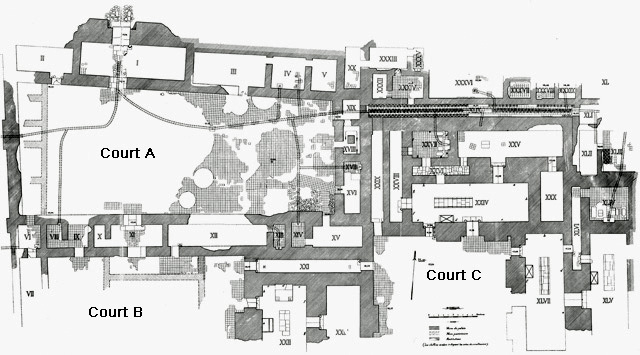
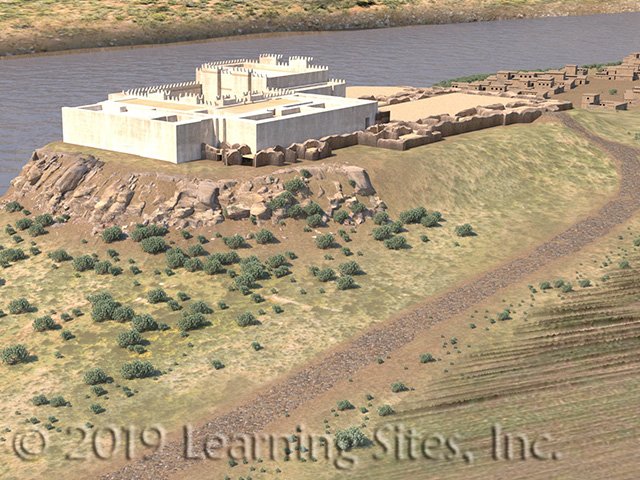 Til Barsib palace aerial view in which the three main suites can be seen clustered around Courtyard C (hover over to enlarge).
Til Barsib palace aerial view in which the three main suites can be seen clustered around Courtyard C (hover over to enlarge).
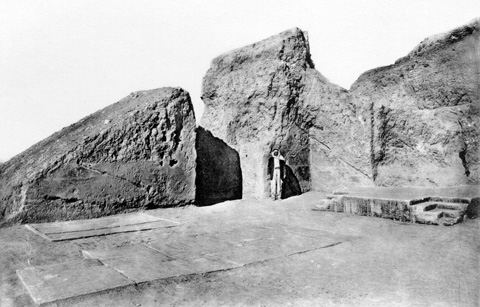 The Throne Room suite encompasses rooms accessible by visitors through Court B or by the royal family (when present) from suites through Court C (see the plan above). The Throne Room itself (Room XXII; pictured at the left as it was found and below, as we have reconstructed it; hover over to enlarge) is 9m wide and was probably about 27m long (extending farther to the south beyond the now-eroded areas), given the placement of doorways and similarity in proportions to other major rooms in the palace. The remains of the stepped dais that held the throne is clearly visible at the right in the photo. The photograph, showing a view NW, is pl.XLI-1 in the excavation report.
The Throne Room suite encompasses rooms accessible by visitors through Court B or by the royal family (when present) from suites through Court C (see the plan above). The Throne Room itself (Room XXII; pictured at the left as it was found and below, as we have reconstructed it; hover over to enlarge) is 9m wide and was probably about 27m long (extending farther to the south beyond the now-eroded areas), given the placement of doorways and similarity in proportions to other major rooms in the palace. The remains of the stepped dais that held the throne is clearly visible at the right in the photo. The photograph, showing a view NW, is pl.XLI-1 in the excavation report.
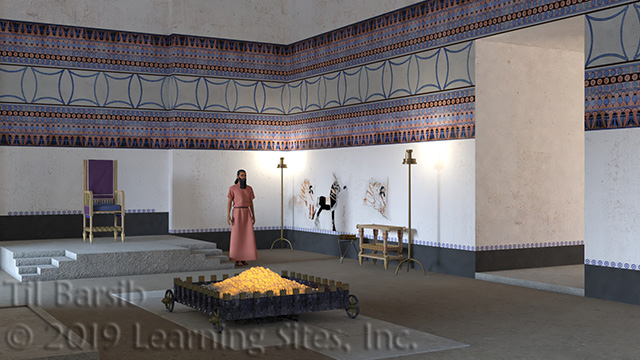 Built into the north wall of the room is a vertical recess framing a low stepped platform (3.60m x 3.50m x 40cm high) that was apparently the throne dais (see our reconstruction at the left, view NE; hover over to enlarge). In front of the platform, on the floor, is a narrow paving of stones, that may have supported an open coal-fired brazier for heat during the winter (as also found in other palaces; see our reconstructions of the throne room of the Northwest Palace, Nimrud). Against the west wall is a shallow basin (possibly for libation rituals). Along with the other important rooms of the palace at Til Barsib, the throne room's walls were decorated with elaborate paintings. An upper band consists of repeating geometric and floral shapes. The only figural scenes to fully survive depict a line of horses and soldiers along the east wall, near the throne area (there were traces of red animals behind the throne in the recess, but not enough for recognizing the full scene).
Built into the north wall of the room is a vertical recess framing a low stepped platform (3.60m x 3.50m x 40cm high) that was apparently the throne dais (see our reconstruction at the left, view NE; hover over to enlarge). In front of the platform, on the floor, is a narrow paving of stones, that may have supported an open coal-fired brazier for heat during the winter (as also found in other palaces; see our reconstructions of the throne room of the Northwest Palace, Nimrud). Against the west wall is a shallow basin (possibly for libation rituals). Along with the other important rooms of the palace at Til Barsib, the throne room's walls were decorated with elaborate paintings. An upper band consists of repeating geometric and floral shapes. The only figural scenes to fully survive depict a line of horses and soldiers along the east wall, near the throne area (there were traces of red animals behind the throne in the recess, but not enough for recognizing the full scene).
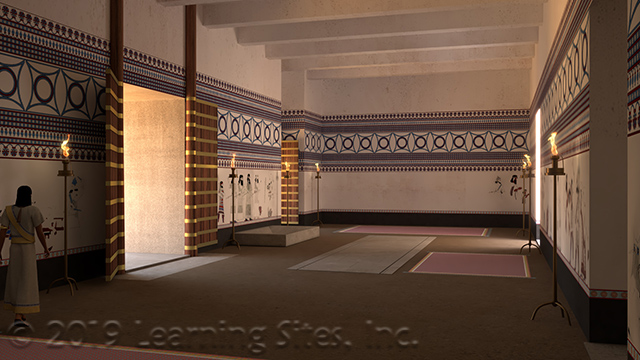 The excavators called the northern set of rooms, the King's Suite. The suite encompasses six rooms at the north of Court C (Rooms XXIV-XXVIII, XXX; see the plan above). The main entry is via Court C into the so-called Reception Room (XXIV; view west reconstructed at the left; hover over to enlarge), which then opens to the other spaces. The Reception Room is the largest in the suite and is arrayed similarly to the Throne Room, with a segment of paved floor near one end, a basin along the wall to the left of the central doorway, and a double-leafed doors leading in. There was originally probably a place for a throne at the west end of the room; but that wall had, in a later phase, been opened to permit access from a side corridor (XXVIII).
The excavators called the northern set of rooms, the King's Suite. The suite encompasses six rooms at the north of Court C (Rooms XXIV-XXVIII, XXX; see the plan above). The main entry is via Court C into the so-called Reception Room (XXIV; view west reconstructed at the left; hover over to enlarge), which then opens to the other spaces. The Reception Room is the largest in the suite and is arrayed similarly to the Throne Room, with a segment of paved floor near one end, a basin along the wall to the left of the central doorway, and a double-leafed doors leading in. There was originally probably a place for a throne at the west end of the room; but that wall had, in a later phase, been opened to permit access from a side corridor (XXVIII).
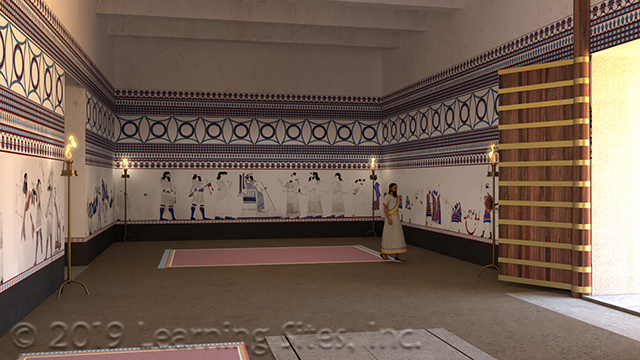 The so-called Reception Room (XXIV; view east reconstructed at the left; hover over to enlarge). This room was probably an administrative office at times when the king was not visiting.
The so-called Reception Room (XXIV; view east reconstructed at the left; hover over to enlarge). This room was probably an administrative office at times when the king was not visiting.
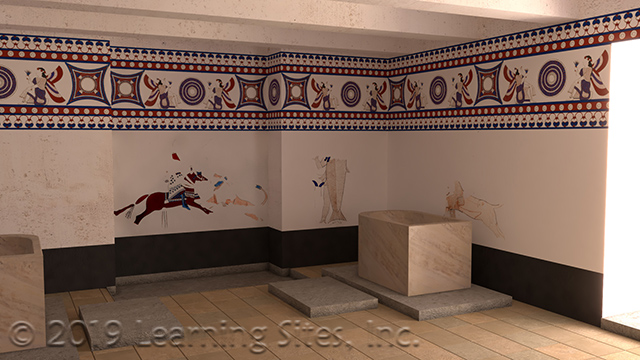 Among the other rooms in the suite are the bathroom (Room XXVII; reconstructed at the left; hover over to enlarge), bedroom (Room XXV), and several subsidiary spaces. This bathroom has two tubs and a recess in the floor with a drain hole for other bathroom functions. The palace had an extensive under-floor sewer system from the bathrooms to connect several other key rooms of the palace and then ran outside the citadel (see the dotted lines in the plan above running across the building).
Among the other rooms in the suite are the bathroom (Room XXVII; reconstructed at the left; hover over to enlarge), bedroom (Room XXV), and several subsidiary spaces. This bathroom has two tubs and a recess in the floor with a drain hole for other bathroom functions. The palace had an extensive under-floor sewer system from the bathrooms to connect several other key rooms of the palace and then ran outside the citadel (see the dotted lines in the plan above running across the building).
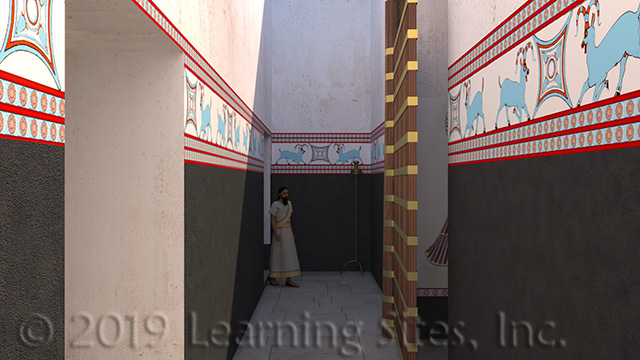 Each of the rooms in the suite (including the corridor connecting the bathroom, reception room and bedroom--shown at the left; hover over to enlarge) had elaborate wall paintings (generally with a decorative geometric and floral band above narrative figural scenes, set on top of a bitumen band presumably to keep the paintings off the damp floor--the corridor at the left has a high bitumen band because the room was open to the sky) that include depictions of the king on his throne receiving visitors, tribute scenes, priests and guardian spirits, animals, and hunting scenes.
Each of the rooms in the suite (including the corridor connecting the bathroom, reception room and bedroom--shown at the left; hover over to enlarge) had elaborate wall paintings (generally with a decorative geometric and floral band above narrative figural scenes, set on top of a bitumen band presumably to keep the paintings off the damp floor--the corridor at the left has a high bitumen band because the room was open to the sky) that include depictions of the king on his throne receiving visitors, tribute scenes, priests and guardian spirits, animals, and hunting scenes.
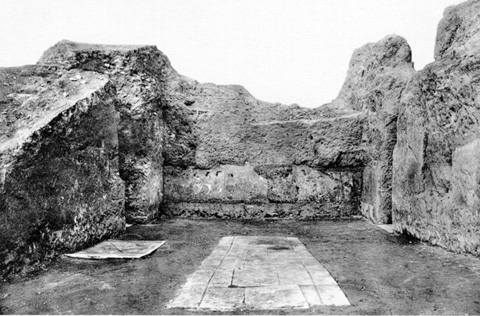 The excavators called the eastern suite the Queen's Suite, which encompasses at least four rooms to the east of Court C (Rooms XLIV-XLVII, see the plan above; if there were additional rooms, they have disappeared to the south). The main entry is via Court C into the so-called Reception Room (XLVII; see below for a reconstruction), which then opens to the other spaces, in an arrangement very similar to the northern suite (and forms a group of rooms familiar from many other Assyrian palaces). The photo at the left is pl.XXXIX-2 in the excavation report.
The excavators called the eastern suite the Queen's Suite, which encompasses at least four rooms to the east of Court C (Rooms XLIV-XLVII, see the plan above; if there were additional rooms, they have disappeared to the south). The main entry is via Court C into the so-called Reception Room (XLVII; see below for a reconstruction), which then opens to the other spaces, in an arrangement very similar to the northern suite (and forms a group of rooms familiar from many other Assyrian palaces). The photo at the left is pl.XXXIX-2 in the excavation report.
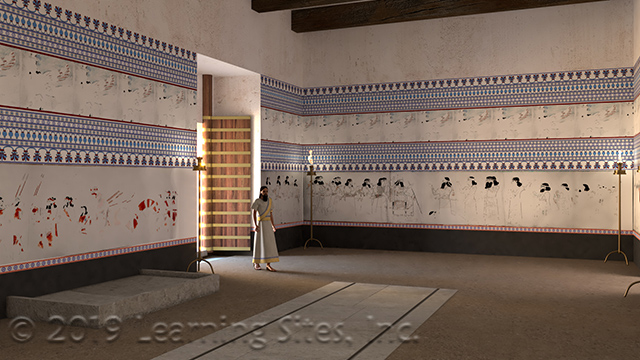 The main reception room as we have reconstructed it, showing a similar viewpoint as the photo above (hover over to enlarge). Current thinking suggests that this room was used by the town administrator to do local business, but then might have been occupied by the king during his visits (the room has the same stones in the floor for a brazier and libation trough against the wall as other primary rooms of similar suites here and at other Assyrian palaces).
The main reception room as we have reconstructed it, showing a similar viewpoint as the photo above (hover over to enlarge). Current thinking suggests that this room was used by the town administrator to do local business, but then might have been occupied by the king during his visits (the room has the same stones in the floor for a brazier and libation trough against the wall as other primary rooms of similar suites here and at other Assyrian palaces).
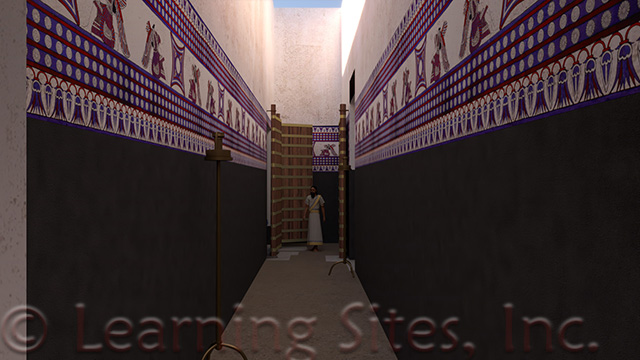 Among the other rooms in the suite are a corridor (Room XLVI) and a bathroom (Room XLIV; a reconstructed view looking northwest from the corridor leading to the bathroom at the left; hover over to enlarge).
Among the other rooms in the suite are a corridor (Room XLVI) and a bathroom (Room XLIV; a reconstructed view looking northwest from the corridor leading to the bathroom at the left; hover over to enlarge).
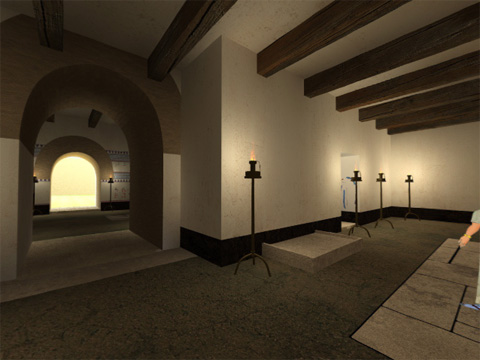 The eastern suite bedroom (Room XLV). Again, each of the rooms has elaborate wall paintings (generally with a decorative geometric and floral band above narrative figural scenes, set on top of a low ground-level bitumen band presumably to keep the paintings off the damp floor) that include depictions of the king on his throne receiving visitors, various procession scenes, guardian spirits, animals, and hunting scenes. There is no clear depiction of a queen.
The eastern suite bedroom (Room XLV). Again, each of the rooms has elaborate wall paintings (generally with a decorative geometric and floral band above narrative figural scenes, set on top of a low ground-level bitumen band presumably to keep the paintings off the damp floor) that include depictions of the king on his throne receiving visitors, various procession scenes, guardian spirits, animals, and hunting scenes. There is no clear depiction of a queen.